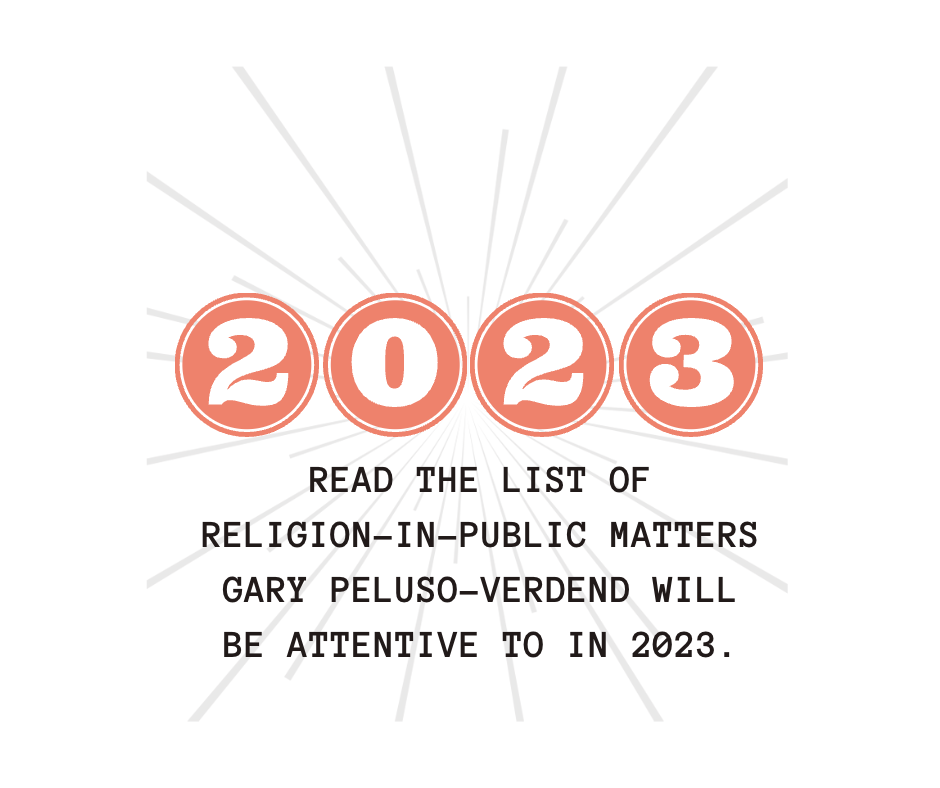Date: January 3, 2023
Public Faces of Religion to Watch in 2023
 As the new calendar year dawns, pundits and journalists often review the top stories of the previous year or predict which will be the big stories of the new year. For such stories I trust the Public Religion Research Institute, the Religion News Service, and The Christian Century.
As the new calendar year dawns, pundits and journalists often review the top stories of the previous year or predict which will be the big stories of the new year. For such stories I trust the Public Religion Research Institute, the Religion News Service, and The Christian Century.
I’m neither reviewing nor predicting. The following are simply religion-in-public matters to which I’ll be paying attention in the new year.
In no particular order:
- Will religious congregations across the theological spectrum become louder in ringing the alarm for the urgency of action to avert catastrophic climate change? Working to reverse the damage human actions have caused to the planet should be viewed as the issue that, if we don’t address it adequately, will worsen suffering for every living being and for the yet-to-be-born. Theologies of salvation, so often in Christian history pointing to the realm of life after death, could be re-purposed: rather than asking “Are you saved?”, we might ask, “What are you and your congregation doing to save all living things, born and yet-to-be-born, from ecological disaster?” Yes, I see the shifts in that language, including from God’s action to ours. In this matter, the shift is critical.
- What role will religion-in-public play in the extended run-up to the 2024 elections? A minority of the population holds dearly to the narratives of white Christian nationalism, and then there is another cohort comprised of “influenced by” but not true believers. How about the rest of us?
- Will local communities resist national polarizing narratives and form coalitions across the democracy-positive political spectrums? In my participation in Braver Angels, I’ve met Oklahomans who are doing just that. For those of us who identify as socially and theologically progressive, we’ve listened—and should be listening—to scholars who have been scraping away colonizer plaster and whitewash and raising their voices for suppressed and oppressed communities. But, as William Barber and Liz Theoharis have shown in the Moral Mondays Movement and Repairers of the Breech, complex coalitions of persons with crisscrossing identities and viewpoints are possible. Who is building such coalitions locally, and including religious communities?
- For four decades, the Christian Right effectively chipped away at abortion access, including by claiming the moral high ground of being pro-life. But the state bans currently being enacted are being challenged on religious grounds. How will the debates about when life begins, what life means, and the relationships between the mother, the fetus, and local communities be influenced by the rest of us who are religious but not of the Christian Right?
- Will public education, one of the truly great American ideas, in Southern and some Western states survive the push to give public tax dollars to parents for school vouchers or directly to religious schools?
- Will in-person attendance in worshiping congregations increase in the post-crisis COVID world or will the pandemic become a permanently-open trapdoor under what had already been declining worship frequency?
- The federal government’s COVID crisis response enabled religious organizations to apply for relief funds. Some congregations used a portion of those funds to upgrade their technology, especially their ability to connect with friends, seekers, and congregants who can’t or choose not to be in the building. Good! But, as we’ve learned in theological education in the shift to requiring internet-delivered technology for teaching: technology wears out and must be replaced. Trained people are needed to run the technology and problem-solve in real time. Equipment, software, and people represent expenses, substantial expenses. From where will those additional funds come?
- The United Methodist Church, in its former incarnations, was once the exemplar of white mainline Protestantism throughout much of the nation. Some historians call the 1800s “the Methodist Century.” Thirty years ago, in an advising session, Martin Marty said to me: “Here’s my take. Methodists used to run the show. They don’t anymore. No one’s told them.” Magnify those comments today. As my beloved denomination is splintering, its cultural influence is now local only, except through some institutions of higher education. No one nationally is trembling, as they did when we split over slavery (and over who can tell a bishop what to do) in 1844, because congregations of The UMC are leaving.
- Which directions will white Christianity move in regard to race, ethnicity, immigration and making the transition into a multi-cultural democracy? Surveys indicate nearly half of white mainline and Catholic congregations preferred the picture of the walled, white dominant U.S. proffered by the former president. It is also the case that predominantly white mainline congregations have positively influenced cultural liberalization.
- Will Christians of any stripe be able to cut through the din of mutual condemnations and resist the politics of excommunication of those not sufficiently pure—political tactics that share much with the worst of religion? And can we offer a message and practices that sound and look like gospel, like good news, full of hope, joy, love, justice, repair, forgiveness, and—yes—reconciliation or, at least, conciliation?


Comments are closed.